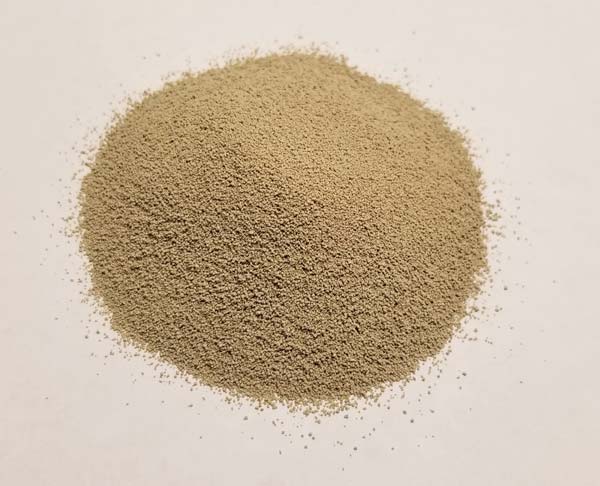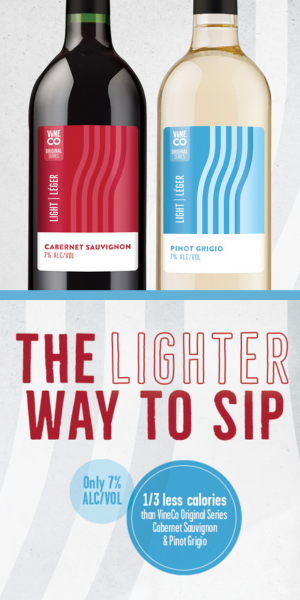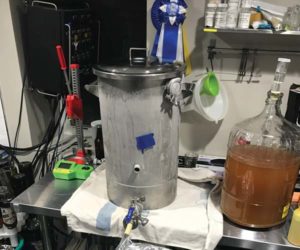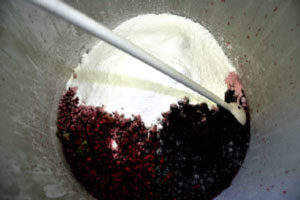Achieving Clarity In Your Wine

You’ve had a great harvest and pressing or got your hands on your favorite kit. Everything has gone to plan with fermentation and the wine is now resting quietly, maturing gracefully. You smell and taste — all points to a great future. Weeks and months pass and you feel the desire to bring your new creation to the bottling stage — taking a sample and pouring it into a glass you realize there is one last, big hurdle. Surprise! The Haze. Coming to a theater near you.
I know this is hardly a great setting for a horror film but clarifying your wine can be a nightmare. Some hazes are stubborn and simply refuse to settle. Some can (and will) clog your filtration machines leaving the room spattered with wine like a Jackson Pollock canvas. We can do something about these and give our wine a brilliant beauty and polish — a look as good as its flavor.
Hazes are a natural and common occurrence in winemaking. They are essentially made up of a variety of compounds from the grapes themselves and microflora that fermented them. They include proteins, tannins and other polyphenolics, pectin and complex carbohydrates, as well as yeast and bacterial cell debris.
The difficulty is that these compounds can create something reminiscent of an emulsion or colloidal dispersion in the wine, described as having turbidity or being unclear. In an ideal world, these compounds sink and settle to the bottom of the vessel where you can then rack the wine off the compacted sediment, yielding crystal clarity. In reality, this is rarely the case and the hazes will often persist to some extent, leaving a wine that looks dull and, in an extreme case, completely opaque.
There is, in fact, an explanation for these, down to a molecular level: These solids remain in suspension because there are molecular forces that keep them floating around. Some are static-like charges, think opposites attract or like rubbing your hair with a balloon. Others are known as hydrophobic, similar to the way oil repels itself from water. If we are lucky, all will settle with time in a cold cellar, the way we are naturally inclined to leave our wine to bulk age over the winter months before bottling in the spring or summer. This is a great practice to allow your wine to begin clarifying gently and naturally.
But there are other means that are commonly used when the wine is not settling to our liking. The process is called fining and we use fining agents (along with gravity) to assist us in reining in these molecular interactions. In brief, fining agents can either bind directly to the particulates, creating larger agglomerates, or they can disturb the molecular interactions that keep these particulates floating around. The goal is to encourage settling over a short period of time, from days to a few weeks, rather than months.
In this article we will explore a variety of common fining agents, their mechanism of action, and how we can strategically use one or more of them to help achieve that sought-after polish in our wine without any negative effects that strip the wine of its character — it’s a fine balance.
Hazes are a natural and common occurrence in winemaking. They are essentially made up of a variety of compounds from the grapes themselves and microflora that fermented them.
For simplicity, I will group the fining agents into two (very) general categories, inorganics and organics. There are also other categories of compounds that can contribute to fining and these are synthetics and enzymes.
Inorganic fining agents – straight from the earth
Commonly used inorganic fining agents are clays and they contain compounds commonly found in soil and mineral deposits. They are predominantly derived of silicon and silicates such as bentonite clay named after its origin of discovery in Fort Benton, Montana. It is also known as montmorillonite from its namesake town in France. Inorganics like silicon, when they dissolve in wine, will assume a negative charge and, therefore, will attract positively charged particulates.
Bentonite is derived from aluminum silicate clay and is commonly found in wine kits. It is not hard to understand why: Bentonite is easy to use and highly effective. It needs to be mixed with enough hot water to create a runny, liquid slurry — if left thick like a paste then it will not be effective. It can be added at the time of inoculation with yeast or post-fermentation. When used during fermentation, it can help to settle the expired yeast cell debris (gross lees) into a more compact mass at the bottom of the vessel, which can greatly help when you perform the first racking.
The great thing about the fine particles of bentonite is that during fermentation the carbon dioxide gas can re-suspend the bentonite where it can go back to work. After fermentation, bentonite can not only help to gather any hazes left over but it can also act as nucleation sites for any remaining dissolved carbon dioxide. In other words, it can help de-gas the wine. Bentonite is often used in white wine fining because in red wine it can bind tannins as well. So if you are not careful you can strip a red wine of some of its structure.
Kieselsol is a mixture of silicon dioxide and colloidal silica and binds phenolic compounds and their complexes. Some of the benefits that kieselsol provides over bentonite is that it comes in a liquid format, so there is no need to rehydrate or dissolve it. You simply measure the dose you require and mix directly into the wine.
Organic fining agents – the building blocks of lifeforms
Some organic fining agents are derived from proteins. Examples include albumin, from egg whites, or isinglass, from fish collagen. They can also be complex carbohydrates like chitosan, from the shells of crustaceans, or sparkolloid, an alginate. Proteins are made of long chains of amino acids with a variety of chemical properties. Within the proteins used for clarifying wine there are amino acids that will assume a positive charge when subjected to the acidic pH (for wine this is typically in the magnitude of pH 3 to pH 4). Therefore, they will attract the negatively charged particulates and help them to precipitate.
I will mention egg white at the top of the list of examples because it’s probably the easiest to come by. And if you’re skilled enough to crack an egg, separate the yolk, and thin it out with water and a pinch of salt, then you can easily dose your wine. As little as half a small egg white is plenty to treat a 5-gallon (19-L) carboy. The active ingredient is albumin, which binds tannins and polyphenolics very well, reducing astringency in overly tannic red wines. Albumin can also help to remove hazes because these tannins can complex with other proteins, so egg albumin can indirectly remove them as well.
Isinglass has been commonly used in winemaking and brewing for centuries and the active ingredient is collagen. The molecular structure of this type of collagen resembles long, heavy coils and they are decorated with positive charges. Isinglass is therefore very adept at flocculating pesky hazes created by lees. When hydrated and dissolved in water these coils can dissociate from one another, revealing areas with additional attractive surfaces to allow for binding more particulates. This is a process called hydrogen bonding.
Sparkolloid is a polysaccharide extract made from alginate (found in the cell walls of algae) and diatomaceous earth. The mixture carries both positive and negative charges and its predominant mechanism of action is to neutralize the charges on a variety of suspended particulates. I have used it when other fining agents have not been effective. Sparkolloid requires dissolving in water and then heating on the stove to activate it before adding it (still warm) to the wine. While you may notice clarification beginning the next day, it can be slow to act, so it is important to let it work for a few weeks so that the sediment can compact as much as possible.
Chitosan is another polysaccharide-based fining agent sourced from crustacean shells. The amino groups (–NH2) in its molecular structure will become positively charged in the environment of wine pH. Its mechanism of action is similar to sparkolloid but it can be stirred directly into the wine and it acts within a couple of days. (For winemakers who prefer to avoid using animal products, there are now plant-based chitosan products sourced from microbial Aspergillus niger.)
Crafty clarifying combinations
Since the inorganic fining agents are helpful in binding proteins (remember, many proteins are positively charged in the context of the wine environment), kieselsol and bentonite can be used in follow-up to using protein-based fining agents. This could help with really stubborn hazes that the protein fining agents may not have been able to completely clear. For example, there are ready-made kits available that offer both chitosan and kieselsol and they are dosed into the wine sequentially, allowing each respective portion to act on its own for a day or more.
Synthetics and Enzymes
I want to also mention that there are some other specialized compounds that can indirectly help with clarifying wine.
Polyvinylpolypyrrolidone (PVPP) is an insoluble synthetic polymer that contains many carbonyl (C=O) groups that, through an attraction known as hydrogen bonding (rather than static charge), can adsorb small polyphenolic compounds on its surface. Some of these polyphenolics not only contribute to haze and astringency but also the potential for browning. Therefore, it can remedy or prevent white wines from becoming dull, tired, or oxidized looking.
If you are after creating a colorless white from a Pinot Gris or were interested in creating a blanc de noir but ended up with too much pink hue, then PVPP treatment can also help adsorb the color compounds. In reds, it can improve the garnet or tawny hues toward a more youthful looking ruby, but at the expense of some color intensity if overdone.
Enzymes can be used as a form of fining. Enzymes are proteins that catalyze chemical reactions and, in the winemaking context, can help digest larger molecules and organisms that contribute to hazes. Two enzymes in particular are pectinase and lysozyme. Pectinases are found in many kinds of microorganisms and even fruits. They serve to break down pectin, chains of sugar molecules that form the plant cell wall “fiber” and are used as the thickening agent to make jam and jellies.
Unlike most fining agents, pectinases are best used at the beginning of fermentation, added to the crush. There, they will work to break down the pectin and soften the must to help with pressing and yield more juice. The action of pectinase is enhanced with the heat that is given off as the yeast are actively fermenting — advantageous for red wine production. Some biochemistry trivia is that an 18 °F (10 °C) rise in temperature will roughly double the activity of most enzymes (to a point of course, don’t boil your musts!). If you are making white wines that are typically fermenting cooler then a bit more time is needed to allow the enzyme to digest the pectin. Either way, you will end up with a must that has already gone through some fining, making the rest of the clarification that much easier.
Lysozyme is also derived from nature, found in secretions such as tears, saliva, milk, and egg white. Nature uses lysozyme as an antibacterial because it breaks down bacterial cell walls (known as peptidoglycan). In winemaking terms, lysozyme can digest malolactic bacteria (Oenococci). Lysozyme can be used to inhibit MLF (malolactic fermentation) but can also be used to stop MLF at any point after it starts. Sterile filtration is a common way to rid wine of malolactic bacteria but practically, for the sake of your filter pump, you’ll want to clarify the wine first, and lysozyme can be a great first step to break down the bacterial growth.
Bench trials and developing your finest strategy
Now that we have some more context around what common fining agents are used and how they work, we need to know something about the wine we wish to clarify. As static charge plays a big role in how proteins behave, it is important to have an estimate of the acidity, especially the pH of your wine. Since pH can affect the magnitude of the charge of molecules it would be worthwhile to adjust the pH of the wine to your liking before you begin adding fining agents.
One of the reasons why a particular fining agent might be slow to act or even largely ineffective is that there is not enough “static cling.” It may mean that you have to use more fining agent than necessary had you made the adjustments beforehand. Winemaking is never a rushed affair and before you add any fining agents to clear a haze it helps to let time and gravity run its course. Have you racked the wine off the gross lees? Degassed through subsequent racking or agitation? Has the wine been subjected to cold temperatures to help precipitate tartrates and encourage general settling of hazes? You can increase the likelihood of successful fining if the wine is given these as a head start toward its final, polished state.
Bench trials are critical for predictability — It is important to note, and I’ve learned from my own mistakes, that you can overdo the fining process. Sure you may end up with crystal clear wine, but at what cost? If not done properly, by adding too much fining agent or the wrong types of fining agent, you can rob your wine of character, color, and even worse, not clarify the wine at all! First, it is most important to know what agent you will use and determine whether or not it is appropriate.
Next, is that you plan an experiment/bench trial on a portion of the wine. A bench trial for fining involves taking a series of samples and then adding increasingly more of a particular fining agent to each subsequent sample. In its simplest form, you have three samples: One with no fining agent added, one with half the recommended dose, and one with a full dose. You can see how these trials can become more and more elaborate as you take a fourth or fifth sample, to which you would add one-quarter or three-quarters of a dose and so on. You could structure your trial to include additional phases in which you would add one particular fining agent, allow it to work, and follow up with a complementary fining agent to determine if there is a synergistic effect to yield maximum clarity. All the while, you will probably want to taste the clarified wine.
Your goal is to attain the desired clarity while not adversely affecting the wine’s mouthfeel and color. As I read back through the years in my wine lab book I remember some of the mistakes along the way. One involved a stubborn haze in a red Bordeaux-style blend I was creating from whole grapes. I took them through a painstakingly long cold soak and then a post-fermentation maceration in order to extract maximum color and a good measure of tannin.
I had a deep, ruby-colored, full-bodied, and well-structured wine on my hands that was pleasing as a young wine and built to age with grace. However, I wanted polish. In my naïveté, I recklessly got carried away with whatever fining agents I had left on hand. In this case, too much bentonite and I did not perform a proper bench trial. I ended up with fabulously clear wine but I had stripped it of its backbone because the wine lost a lot of the desirable structure in its mouthfeel. It even cost me a bit of that deep color I worked so hard to extract.
Vegan wines – yes, it’s a thing
One last thought about fining agents is that you may have come across labels among the store shelves indicating the wine is “vegan friendly.” Where does this come from — aren’t grapes vegan anyway? The answer comes, in part, from the use of fining agents that are not animal-derived, such as clays and plant-based products, or perhaps not using fining agents in the wine at all; letting gravity and time work their magic.
Alas, this article has settled. Thanks for remaining in suspension for all the juicy technical information and I hope it was able to provide you some clarity on how you will finish your own wines. Cheers!







